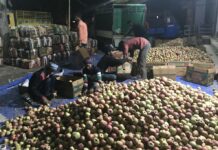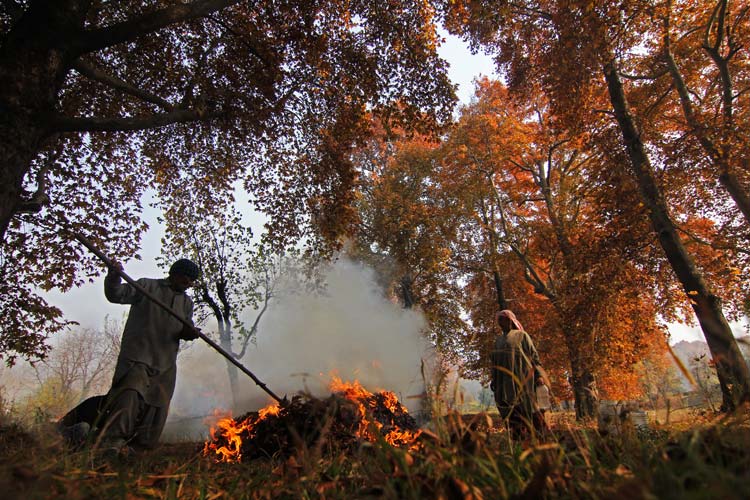Two brothers laboured for 15 years in experimental orchards. One day, when they were sure that they will never be regularised, they decided to replicate their skills at home and now they have a yearly turnover of more than one crore rupees, reports Ibtisam Fayaz Khan

Not every rupee of Kashmir’s horticulture economy is in apple. There is perhaps more money in trees, to be exact in apple saplings. Two brothers of a Budgam village have a chain of nurseries and selling rootstocks to cultivators is a roaring business. A decade long struggle has made them millionaires.
Barely 20 km from the Srinagar city centre is Budgam’s Soibugh belt that has an elevated area with a serene ambience. A macadamized road passes through the lush green thick plantation to unveil the enviable success story of the two brothers.
Their story dates back to a decade when the Sanoor Kalipora duo got an idea that they must get into the particular business.
The two brothers, Bilal Ahmad Mir, 46, and Ghulam Muhammad Mir, his elder brother, were working as contractual workers at the ICAR run Central Institute of Temperate Horticulture (CITH) in Rangreth where they got basic training about several agriculture techniques like grafting, budding and many others. CITH is a major research centre with a focus on horticulture. The centre has been evolving techniques and varieties and then disseminating them to growers. At one point in time, it was here the Afghan growers picked the art of growing Saffron. At CITH, they were initially getting Rs 8,000, which was later hiked by Rs 2000.
“Earlier, grafting was fundamental to get the trees to become fruitful but now scientists developed the rootstocks that do not require grafting,” the elder Mir said. “Mostly, these rootstocks are imported from foreign and then distributed within the country. These high-density varieties get into production within two years after grafting. That is how we became passionate about it.”
The Start
At CITH, Mir said he asked the managers to regularise his service. Officials refused because he was overage. Then and there, the brothers decided to part ways. By then, they had given almost 15 years to CITH and had picked every aspect of the art of grooming trees.
“We decided to purchase 500 rootstocks from CITH on two kanals of land that we had. We did budding and grafting and it started giving samples in the first three years of growth,” Mir remembers. “We handled the venture personally and worked day and night like labourers”.

Two years later, the Mir duo sold 100 plants. The next year, it was 3000 plants. Then it went up to 6000 plants. In the fourth year, they sold 16000 plants and jumped to 50,000 later. “Two years back, our turnover was Rs 1.15 crore,” Mir said. “Currently, we generate employment for almost 30 families. We provide pick and drop services to them and their wages per day are Rs 500,” said Mir.
“Initially we used to have a couple of trees to demonstrate but now that is no more required because the customers know what we sell,” Mir said. “Earlier we used to take the plants to customers personally and now we deliver the orders using the vehicle.”
Multiple Nurseries
Mirs’ run two nurseries. The primary one is their ancestral land spread over 10 to 12 Kanals of paddy fields. Another nursery is spread across 35 Kanals, this one they have taken on rent. This huge nursery is rain-fed with around 33,000 plants of diverse fruit rootstocks.
“We have peaches, apricots, apples of certified premium foreign quality which are tested in various laboratories in Kashmir by various testing organisations, and most of them grow in about 2-3 years,” Mir said while guiding this reporter around the nursery. “Our only priority has been to sell the people premium quality rootstock.”
Red Apple
Redlove apples were successfully produced by Markus Kobelt in 2010 in the Swiss Rhine Valley, after over 20 years of experimentation and cross-pollination trials, including breeding in scab resistant properties. This variety is perhaps the world’s only European red-fleshed variety developed for commercial production. Now grown in China and Australia outside Europe, the Redlove apples get their name from their deep red colouring and from a distinct heart shape formed within its flesh when the fruit is quartered. The hybrid varieties are favoured as a speciality line of red-fleshed fruits, valued for their novel, dark hues, and are utilized as both fresh eating and cooking apple.
Somehow, Mirs’ managed the rootstock. Right now, they have planted two long lines of this variety, properly budded and grafted. “Unless we do not analyse its success, we will not introduce it in the market,” the Mir Jr said. They are normally busy in September, the month when they book orders for supply. The process concludes by November.

They initially plant the rootstock in the mother block and later shift the plants to another nursery.
Not Apples Alone
Mirs’ are into fruit nurseries and not in apple nurseries. They have almost everything that can grow in a Kashmiri orchard. “We keep Chamburas, which mostly the urban people buy as decorations, these plants don’t require DDT or any other kind of fertilisers,” Bilal said. “Last year, we produced about 1800 walnuts and we are experimenting with every aspect for new types of products.”
Watching their fathers’ succeed, the next generation have joined the two brothers. Their sons and daughters have shown a lot of interest and are keen to take it to the next level.
“My eldest of the three daughters, Mehak, is in the eleventh grade and she has a tremendous knack for horticulture and is aspiring to join SKUAST to study and get a degree in this field,” Ghulam Muhammad Mir said. Their next generation is rooted on the ground and aware of the struggle their fathers’ made in creating the rags to riches story.















